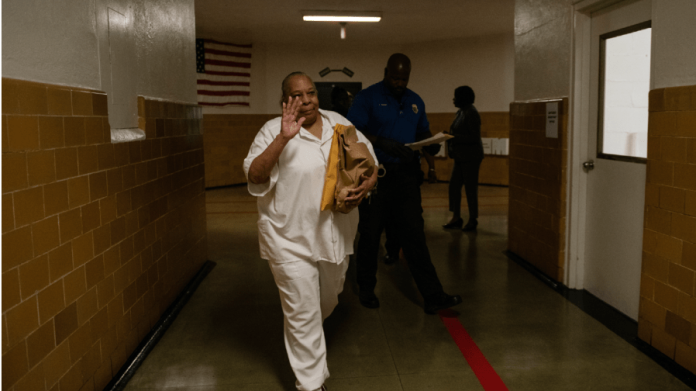
The two of us have spent a good chunk of our lives on opposite sides of prison bars.
One of us worked for 16 years in the federal Bureau of Prisons, including a stretch as acting director during the first Trump administration. The other spent 14 years in federal prison before fighting to help hundreds of thousands of incarcerated people earn their freedom and successfully reenter society.
Despite these different backgrounds — or perhaps because of them — we agree on one thing: Our criminal justice system can and must do much more to enhance safety and justice for all Americans.
That’s why we were encouraged when, last month, the Bureau of Prisons quietly issued a new directive that will help incarcerated individuals return more quickly to their families and communities.
Although we are optimistic, the devil is in the details. For this policy to succeed, it must be implemented fairly and consistently for all who qualify.
The U.S. has made real progress on criminal justice over the past few decades. The crime rate has declined 61 percent since its peak in 1991. The prison population has shrunk by roughly 25 percent since 2009, and racial disparities have dropped by 40 percent.
This progress came from thoughtful, bipartisan reforms. Between 2007 and 2018, 35 states passed sentencing and corrections reform laws. At the federal level, two landmark measures — the Second Chance Act and First Step Act — stand out.
Signed in 2008 by President George W. Bush, the Second Chance Act funds state and local programs that help incarcerated people reenter their communities.
Ten years later, Trump signed the First Step Act, which modified mandatory minimums, expanded opportunities for people to earn time credits toward early release and increased access to rehabilitative and vocational programs.
Many were surprised when Trump, who had promised tougher sentences as he campaigned for office, championed the First Step Act. But he pressured Republicans in Congress to support it and enthusiastically signed it into law, calling it proof that “America is a nation that believes in redemption.”
In his second term, Trump has sent mixed signals so far. His Justice Department cut more than $500 million in state and local criminal justice grants, and Attorney General Pam Bondi rolled out new tough-on-crime policies.
At the same time, Trump created a new “pardon czar” position to advise him on presidential clemency decisions, appointing Alice Marie Johnson — who served over 20 years in federal prison before receiving clemency from Trump — to the role.
The latest advancement came in June when Bureau of Prisons Director William K. Marshall III directed the bureau to fully implement both the Second Chance Act and First Step Act.
Declaring “the dawn of a new era,” Marshall promised the policy change would save money, reduce strains on corrections staff and facilities and make it easier for many incarcerated people to return home and contribute to society.
This latter point is the centerpiece of the First Step Act. The act allows low-risk individuals who complete rehabilitative programs to earn “time credits” which can be applied toward early release or to serve the remainder of their sentences in home confinement or residential reentry centers.
Since its passage, the First Step Act has proven effective. A Council on Criminal Justice analysis found that individuals released under the First Step Act were 55 percent less likely to return to prison than people with similar profiles released before the law took effect. These lower recidivism rates held even among those considered higher risk by the Bureau of Prisons.
Yet challenges remain. Despite receiving more than $400 million annually under the First Step Act, the Bureau of Prisons has long claimed it lacks the contract capacity to support home confinement and reentry centers.
There has also been confusion about whether the First Step Act and Second Chance Act could be applied simultaneously. Both the Biden and Trump administrations initially said they could not, before allowing it.
The new Bureau of Prisons policy promises to solve these issues, but its success will depend on implementation. The director’s message must reach and be embraced by all corners of the system.
We have seen encouraging signs thus far. This month, the Bureau of Prisons launched a task force to address logistical hurdles faced by staff — a promising step toward ensuring the policy is put into practice.
Going forward, we see three top priorities.
First, communication. With over 155,000 employees, the Bureau of Prisons must ensure every staff member understands this policy and why it matters.
Second, training. Too often, people remain behind bars simply because staff aren’t properly trained on how to apply the law.
And third, accountability. Bureau of Prisons leaders must quickly address any staff who resist the changes — whether through correction or removal.
In the early months of Trump’s second term, we have seen America’s political divides on display, from the “big beautiful bill” to the bombing of Iran to new tariffs.
Criminal justice reform should be an exception. It offers a rare opportunity for common ground — a chance to advance solutions that make our communities both safer and more just.
Hugh Hurwitz worked for the Bureau of Prisons for more than 16 years, including as acting director during the first Trump administration, and is a member of the Council on Criminal Justice. Louis L. Reed, who served nearly 14 years in federal prison and later helped pass over 30 state and federal bills, including the First Step Act of 2018. He is a member of the Council on Criminal Justice’s Board of Trustees.

